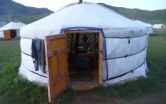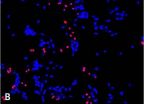(Press-News.org) Climate was very much on Genghis Khan's side as he expanded his Mongol Empire across northeastern Asia.
That link between Mongolia's climate and its human history echoes down the centuries, according to findings reported in this week's issue of the journal Proceedings of the National Academy of Sciences (PNAS).
But climate may no longer be the boon it was during the latter, wetter part of Genghis Khan's reign. The early years were marked by drought.
Mongolia's current drought conditions could have serious consequences for the Asia region's human and other inhabitants.
The discovery linking ancient and modern history hinges on wood. Trees provide an extensive climate record in their rings.
The tree rings' tales of ebbs and flows in water availability show that Genghis Khan took power during a severe drought, says Amy Hessl, a geographer at West Virginia University and co-author of the paper.
But, the scientists found, the rapid expansion of Genghis Khan's empire coincided with the wettest period in the region during the last millennium.
"Through a careful analysis of tree-ring records spanning eleven centuries, the researchers have provided valuable information about a period of great significance," says Tom Baerwald, a program director for the National Science Foundation's (NSF) Dynamics of Coupled Natural and Human Systems (CNH) Program, which funded the research.
CNH is one of NSF's Science, Engineering and Education for Sustainability (SEES) programs. CNH is supported by NSF's Directorates for Geosciences; Biological Sciences; and Social, Behavioral & Economic Sciences.
"The results also provide insights into the complex interactions of climate, vegetation and human activity in semi-arid regions today," Baerwald says.
Though political realities would also have played into Genghis Khan's power grab, the regional climate at the time appears to have supported his empire's expansion.
The climate provided literal horsepower as armies and their horses fed off the fertile, rain-fed land.
"Such a strong and unified center would have required a concentration of resources that only higher productivity could have sustained, in a land in which extensive pastoral production does not normally provide surplus resources," the paper states.
While the ramifications for past history are significant, so, too, are they for today's.
The scientists believe that human-caused warming may have exacerbated the current drought in central Mongolia, similar to the drought that coincided with Genghis Khan's initial rise to power.
"If future warming overwhelms increased precipitation, episodic 'heat droughts' and their social, economic and political consequences will likely become more common in Mongolia and Inner Asia," according to the paper.
INFORMATION:
Hessl co-authored the report with scientists Neil Pederson of the Lamont-Doherty Earth Observatory, Nachin Baatarbileg of the National University of Mongolia, Kevin Anchukaitis of the Woods Hole Oceanographic Institution and Nicola Di Cosmo of the Institute for Advanced Study.
-NSF-
Climate of Genghis Khan's ancient time extends long shadow over Asia of today
Current drought in Mongolia could have serious consequences
2014-03-12
ELSE PRESS RELEASES FROM THIS DATE:
NASA sees remnants of Tropical Cyclone Hadi in So. Pacific
2014-03-12
Tropical Cyclone Hadi is now a remnant low pressure area in the Southern Pacific Ocean. NASA's Aqua satellite passed over the storm and captured a visible image of it on March 12.
When NASA's Aqua satellite flew over Hadi's remnants, the MODIS instrument aboard captured a visible image that showed the strongest thunderstorms associated with the low appeared south of the center of circulation. The center was located near 15.1 south and 156.1 east, about 585 nautical miles/673.2 miles/ 1,083 km west of Vanuatu.
The Joint Typhoon Warning Center or JTWC noted that animated ...
Skating to the puck or avoiding the penalty box in health care?
2014-03-12
LEBANON, NH (March 12, 2014) – In a Viewpoint published in the March issue of JAMA, Researcher Jeremiah Brown of The Dartmouth Institute for Health Policy & Clinical Practice and colleagues, Hal Sox and David Goodman, question whether the Centers for Medicare & Medicaid Services' use of financial penalties is the right tack for changing the behavior of hospitals.
The researchers examine the pros and cons of the hospital readmissions reduction policy in the Affordable Care Act as an example of similar CMS initiatives.
"Using financial incentives to change practice ...
The immune system's redesigned role in fighting cancerous tumors
2014-03-12
LOS ANGELES (March 11, 2014) – Researchers in the Cedars-Sinai Samuel Oschin Comprehensive Cancer Institute eradicated solid tumors in laboratory mice using a novel combination of two targeted agents. These two synergistic therapies stimulate an immune response, ultimately allowing solid tumors to act as their own cancer-fighting vaccine.
The study's findings, published in the journal Cancer Research, are the first to use these combined agents as an immune stimulator and may have the potential to kill cancerous cells in solid tumors, including some of the most aggressive ...
Fruit flies help uncover tumor-preventing protein complex
2014-03-12
A team of researchers from Duke-NUS Graduate Medical School have discovered a protein complex that disrupts the process known as dedifferentiation (1), known to promote tumor development.
Dedifferentiation (reversion) is a process that leads progenitor (2) or mature cells to become 'ectopic neural stem cells' which causes tumors. By detecting this protein complex, Duke-NUS researchers have shed light on a process that inhibits tumor development and gives hope for the discovery of therapies and treatments that target tumor prevention through this pathway.
Researchers ...
Researchers slow pancreatic cancer growth by blocking key enzyme
2014-03-12
A research team from Imperial College London has shown that blocking the function of an enzyme known as Hhat slows the growth and spread of pancreatic cancer, by preventing a protein called Hedgehog from stimulating nearby normal cells to help the cancer.
The study, funded by the UK research charity Pancreatic Cancer Research Fund, examined the role of Hedgehog, whose usual job is to send signals to cells in embryos to divide and grow into the correct body parts. But while Hedgehog usually switches off when the embryo is formed, in many cancers, including pancreatic, ...
Superior visual thinking may be key to independence for high schoolers with autism
2014-03-12
Researchers at UNC's Frank Porter Graham Child Development Institute (FPG) and UNC's School of Education report that teaching independence to adolescents with autism can provide a crucial boost to their chances for success after high school.
"We explored many factors that contribute to the poor outcomes people with autism often experience," said Kara Hume, co-principal investigator of FPG's Center on Secondary Education for Students with Autism Spectrum Disorders (CSESA). "It's clear that teaching independence to students with autism should be a central focus of their ...
Chronic pain research explores the brain
2014-03-12
New insights into how the human brain responds to chronic pain could eventually lead to improved treatments for patients, according to University of Adelaide researchers.
Neuroplasticity is the term used to describe the brain's ability to change structurally and functionally with experience and use.
"Neuroplasticity underlies our learning and memory, making it vital during early childhood development and important for continuous learning throughout life," says Dr Ann-Maree Vallence, a Postdoctoral Fellow in the University of Adelaide's Robinson Institute.
"The mechanisms ...
Surface characteristics influence cellular growth on semiconductor material
2014-03-12
Changing the texture and surface characteristics of a semiconductor material at the nanoscale can influence the way that neural cells grow on the material.
The finding stems from a study performed by researchers at North Carolina State University, the University of North Carolina at Chapel Hill and Purdue University, and may have utility for developing future neural implants.
"We wanted to know how a material's texture and structure can influence cell adhesion and differentiation," says Lauren Bain, lead author of a paper describing the work and a Ph.D. student in ...
Alpha-synuclein effects on dopaminergic neurons: Protection or damage?
2014-03-12
Alpha-synuclein is a principal component of Lewy bodies and Lewy neurites, which are pathologic hall-marks of Parkinson's disease. Alpha-synuclein is generally considered to play a role in synaptic activity, although its function remains largely unknown. Accumulative evidence has been shown that aggregated extracellular alpha-synuclein fibrils can be internalized in the cells and enhance the intracellular formation of protein inclusions, leading to cell death. Conversely, there is emerging evidence suggesting that alpha-synuclein has also neuroprotective effects. In one ...
PD-L1: A potential treatment target for multiple sclerosis
2014-03-12
Experimental allergic encephalomyelitis is a mouse model of human multiple sclerosis with similar pathology and pathogenesis. Th1 cells play an important role in the pathogenesis of experimental allergic encephalomyelitis. Therefore, Qun Xue, Fanli Dong and co-workers from the First Affiliated Hospital of Soochow University in China speculated that programmed cell death 1 ligand 1 (PD-L1) plays an important role in the pathogenesis of multiple sclerosis. A recent study by these researchers published in the Neural Regeneration Research (Vol. 8, No. 35, 2013) found that the ...
LAST 30 PRESS RELEASES:
Chicago health information leader recognized for raising CPR readiness and blood pressure awareness
The Intimate Animal, a new book from Kinsey Institute Executive Director Dr. Justin Garcia
When blue-collar workers lose union protection, they try self-employment
New video dataset to advance AI for health care
MEA-based graph deviation network for early autism syndrome signatures in human forebrain organoids
New modeling approach sheds light on rare gut disease
Study documents potentially hazardous flame retardants in firefighter gear
Can certain bacteria regulate aging of the immune system and its related alterations?
AI model helps diagnose often undetected heart disease from simple EKG
There are fewer online trolls than people think
Cell membrane fluctuations produce electricity
Jeonbuk National University study shows positive parenting can protect adolescents against self-harm
Surface-engineered ZnO nanocrystals to tackle perfluoroalkyl substance contamination
This new understanding of T cell receptors may improve cancer immunotherapies
A new fossil face sheds light on early migrations of ancient human ancestor
A new immunotherapy approach could work for many types of cancer
A new way to diagnose deadly lung infections and save lives
40 percent of MRI signals do not correspond to actual brain activity
How brain-inspired algorithms could drive down AI energy costs
Gum disease may be linked to plaque buildup in arteries, higher risk of major CVD events
Contrails are a major driver of aviation’s climate impact
Structure of dopamine-releasing neurons relates to the type of circuits they form for smell-processing
Reducing social isolation protects the brain in later life
Keeping the heart healthy increases longevity even after cancer
Young adults commonly mix cannabis with nicotine and tobacco
Comprehensive review illuminates tau protein's dual nature in brain health, disease, and emerging psychiatric connections
Book prepares K-12 leaders for the next public health crisis
Storms in the Southern Ocean mitigates global warming
Seals on the move: Research reveals key data for offshore development and international ecology
Sports injuries sustained during your period might be more severe
[Press-News.org] Climate of Genghis Khan's ancient time extends long shadow over Asia of todayCurrent drought in Mongolia could have serious consequences








